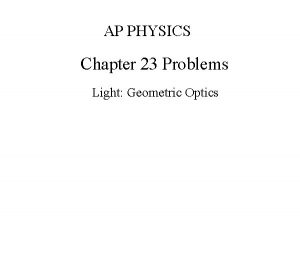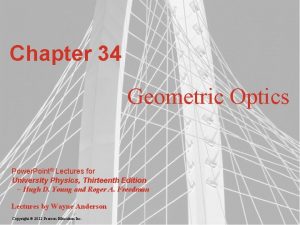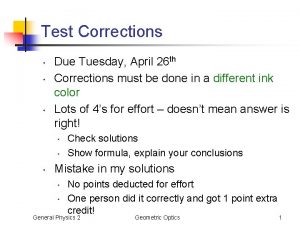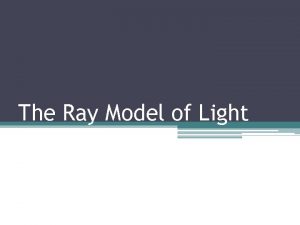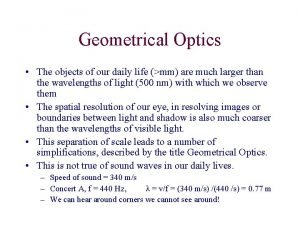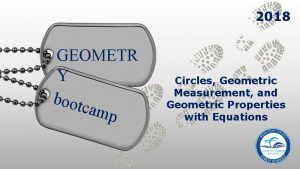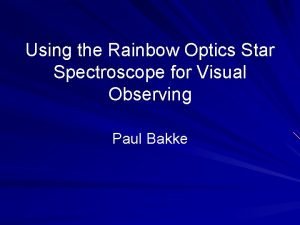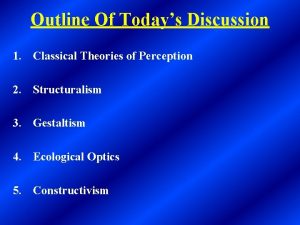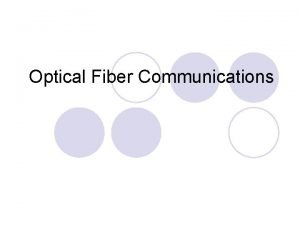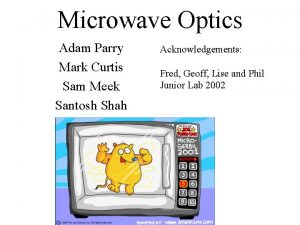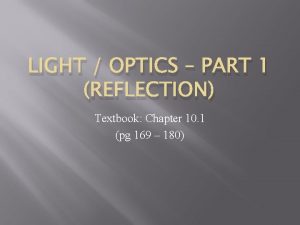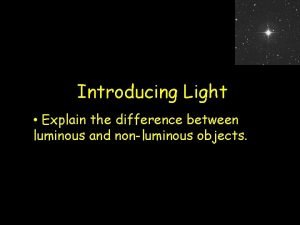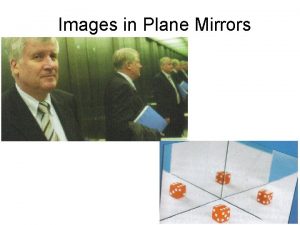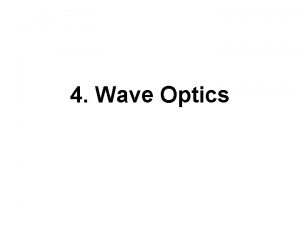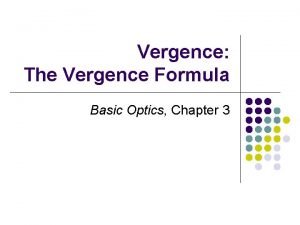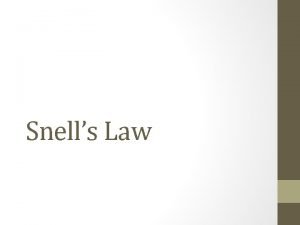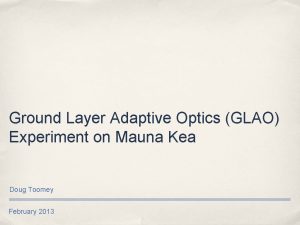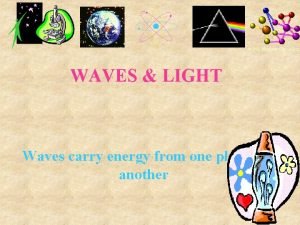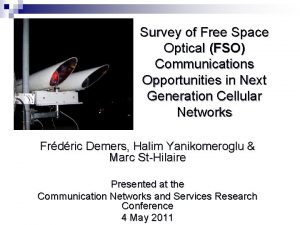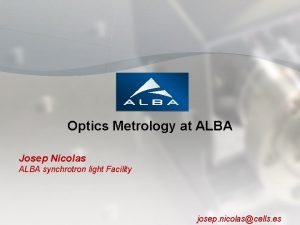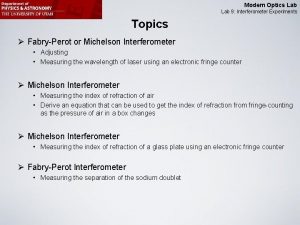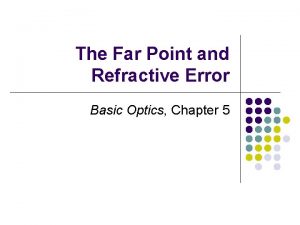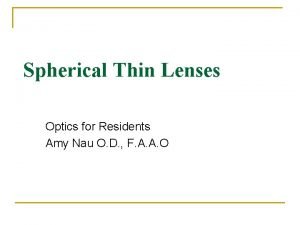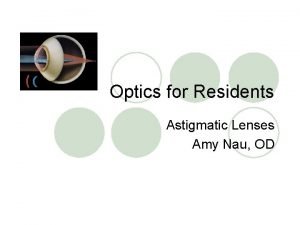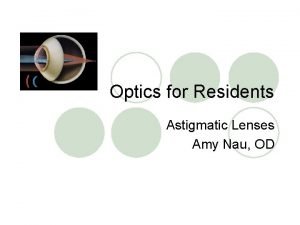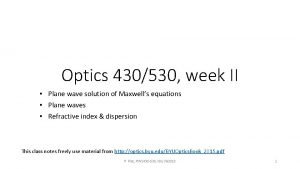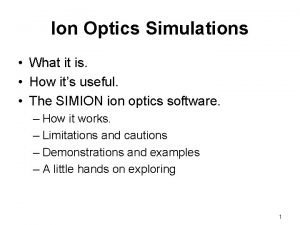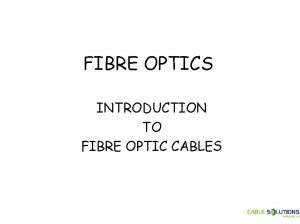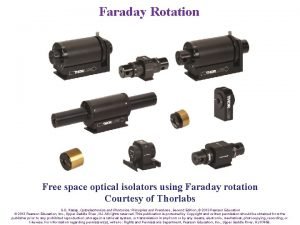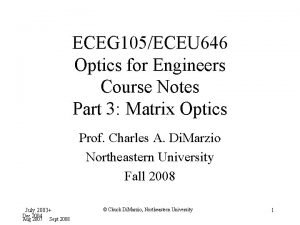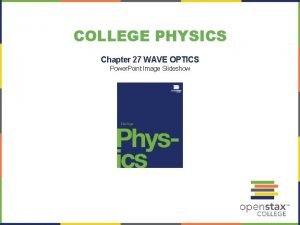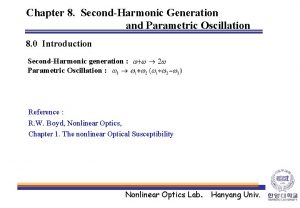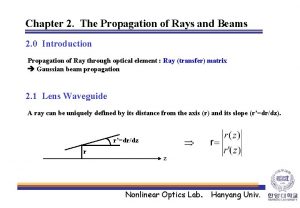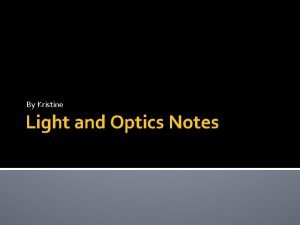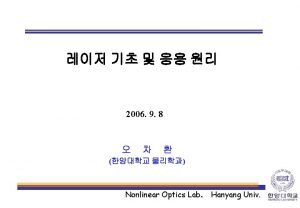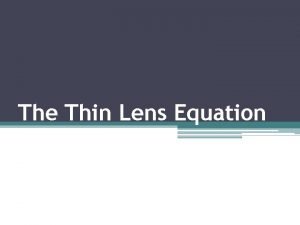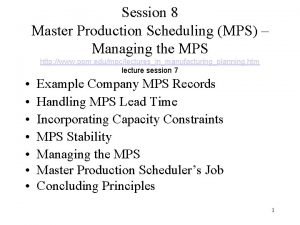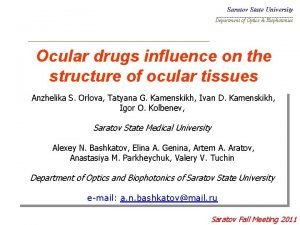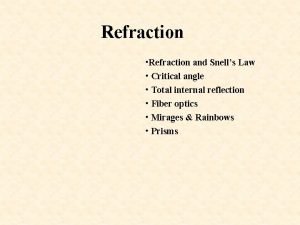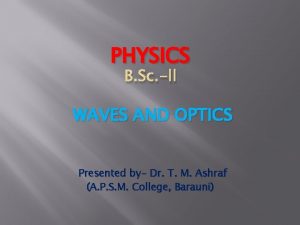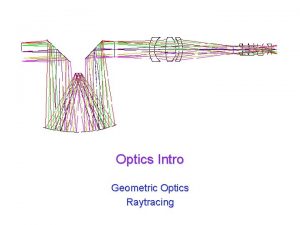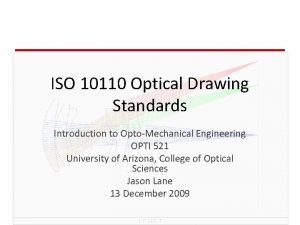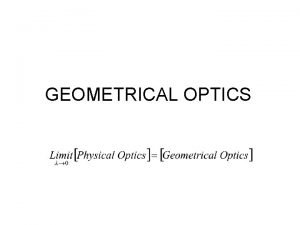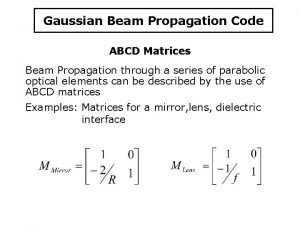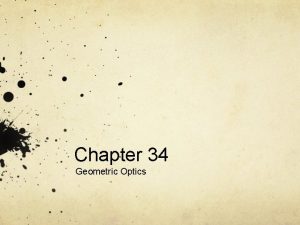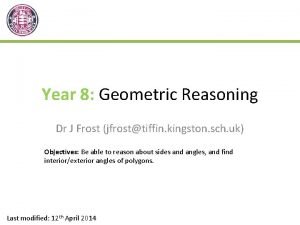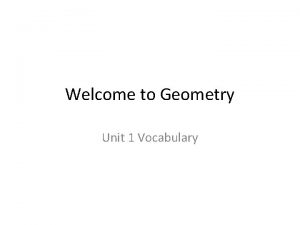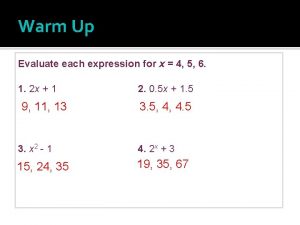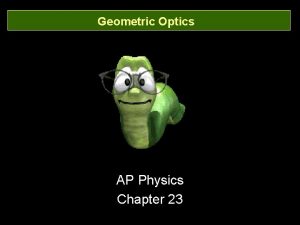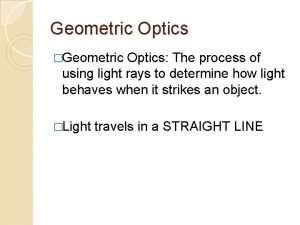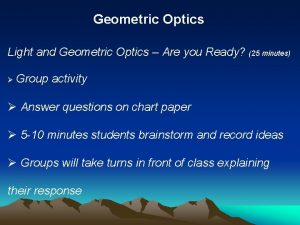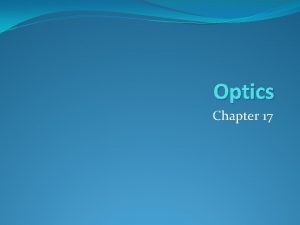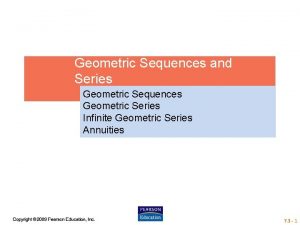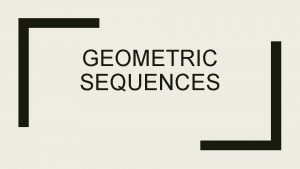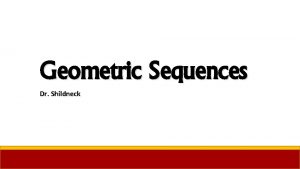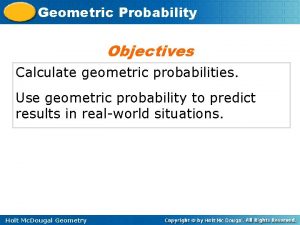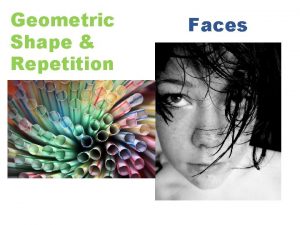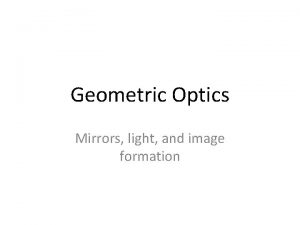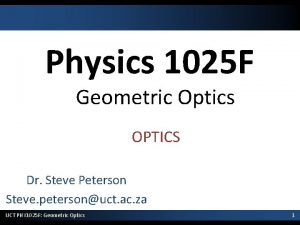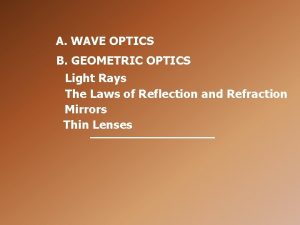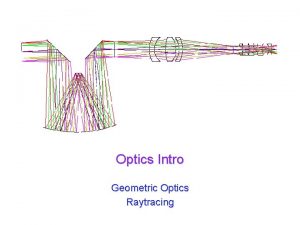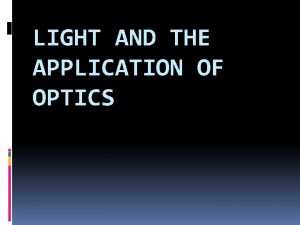Chapter 34 Geometric Optics What is Geometric Optics











































































- Slides: 75

Chapter 34 Geometric Optics

What is Geometric Optics It is the study of light as particles. Geometric optics treats light as particles (or rays) that travels in straight lines. Physical optics (wave optics) deals with the wave nature of light, such as the spreading of waves (diffraction) and the interference of waves.

Two types of lens

Converging and Diverging Lens

Symbols Converging Lens = Convex Lens = Positive Lens Diverging Lens = Concave Lens = Negative Lens

Some notations F: focal point O: object I: image Principle axis Your textbook: f: focal length s': image distance s: object distance f: focal length i: image distance p: object distance

Converging Lens

Converging Lens (thin) Rules: 1. Rays parallel to axis Pass through focal point 2. Rays through focal point Pass parallel to axis 3. Rays through the center Pass through unaffected

Where is the image? Trace at least two light rays. The image is at where the rays meet.

How to find the image Trace two rays of light. Where they meet is where the image is.

Example Complete the light rays below to find the image. Image

What if you move the object beyond 2 F?

Solution

In fact all light rays from the object pass through the image You only need two rays to find the image

What if you now move it between F and 2 F?

At F?

Between 0 and F?

Demo Exploration of Physics

Summary

Real and Virtual Image Real image can be projected directly on a screen. Virtual image cannot be projected directly on a screen without extra lenses or mirrors. Real image forms when rays actually converge and meet. Virtual image forms when rays diverge and do not meet. Position of a virtual image is found by tracing the rays backward

Real and virtual image Real Virtual

Lens Equation

Lateral Magnification

Magnification is related to i and p

Magnification is related to i and p

The sign of magnification m Since the image is inverted, we use minus sign in front.

The sign of i i is positive if the image is on the right i is negative if the image is on the left i >0 i<0

The sign of m i >0, m<0, inverted i <0, m>0, upright

Example Assume f = 1 m, complete the table below (in meters) p ∞ 3 2 1. 5 1 0. 5 i m

Solution Assume f = 1 m, complete the table below. p i m ∞ 3 1 1. 5 0 -0. 5 2 2 -1 1. 5 3 -2 1 0. 5 ∞ -1 ∞ +2

Diverging Lens (thin) Rules: 1. Rays parallel to axis Pass through focal point 2. Rays through focal point Pass parallel to axis 3. Rays through the center Pass through unaffected

Negative f Diverging lens obeys the lens equation too. Except that f is now negative 2 cm Example: f =-2 cm

Complete the light rays and find the image

Solution

Different p

The typical case for concave lens For concave lens, the image is always virtual and upright, no matter where the object is.

Can you see why i is always negative?

Example: Diverging Lens You are given a diverging lens of focal length 20 cm. You want to form an virtual image that is 1/3 the height of the object. Where should the object be placed?

Ray Diagram for the Example

Converging or diverging lens? Converging

Converging or diverging lens? Diverging

Converging or diverging lens? Converging

Confusing signs Converging Lens Divergin Convergin Divergin g g g Lens Mirror Other name Convex Lens Concave Mirror Convex Mirror f + - i when image is on the left - - + + i when image is on the right + + - -

Lensmaker’s Equation Proof not required. No need to memorize, will be given in the exam. One question in Mastering Physics. R>0 if convex (bulging) toward the object.

Curved mirrors

Curved Mirrors Concave mirror Converging mirror Positive mirror Convex mirror Diverging mirror Negative mirror

Terminology

Symbols Converging Mirror = Concave Mirror Diverging Mirror = Convex Mirror

Only one focal point for curved mirrors A lens has two focal points (one on each side of the lens), but a curved mirror only has one focal point. It is important to remember where they are. Concave mirrors: F in front of the mirror Convex mirrors: F behind the mirror

Concave Mirror Rules F Rules: 1. Rays parallel to axis Reflect through focal point 2. Rays through focal point Reflect parallel to axis 3. Rays through the center Reflect with equal angle Really the same rules as converging lens

Convex Mirror Rules: 1. Rays parallel to axis Reflect through focal point 2. Rays through focal point F Reflect parallel to axis 3. Rays through the center Reflect with equal angle Really the same rules as diverging lens

Summary

Lens Equation applies f is positive for concave mirror f is negative for convex mirror i is positive if image is in front of the mirror i is negative if image is behind the mirror

Concave mirror 1

Concave mirror 2

Concave mirror 3

Concave mirror 4

Concave mirror case 1 & 4

Convex mirror Find the image F Virtual image

Convex mirror For convex mirror, the image is always virtual and upright, no matter where the object is.

Convex mirror

Multiple lenses In the case when the first lens form a image in front of the first lens, simply treat the image as the object for the second lens. We will skip the case when the first lens gives an image behind the second lens.

Example: Image of an image An object 8 cm high is placed 12 cm to the left of a converging lens of focal length 8 cm. A second converging lens of focal length 6 cm is placed 36 cm to the right of the first lens. Find the position and size of the final image.

Virtual Object http: //science. sbcc. edu/~physics/flash/optics/virtualobject. html p is negative for virtual objects

Confusing signs Converging Lens Divergin Convergin Divergin g g g Lens Mirror Other name Convex Lens Concave Mirror Convex Mirror f + - i when image is on the left - - + + i when image is on the right + + - -

Summary Both equations are true for lens and mirrors, but you have to be very careful about the signs!

Camera

Area of view and focal length Longer focal length, the less light is collected, need to compensate by increasing the diameter of the aperture D. You want to keep the “f-number” f/D constant for the same intensity.

The eye

Nearsighted Eye

Farsighted eye

Microscope

Telescope

Reflecting Telescope

IQ question A piece of glass is placed above the words “LEAD OXIDE”. LEAD appears inverted, but not oxide. Explain.
 Venn diagram of geometric optics and physical optics
Venn diagram of geometric optics and physical optics Difference between ray optics and wave optics
Difference between ray optics and wave optics Optics
Optics Geometric optics ppt
Geometric optics ppt Physics 2
Physics 2 Light ray model
Light ray model Geometric optics in real life
Geometric optics in real life 2018 geometry bootcamp answers
2018 geometry bootcamp answers Rainbow optics star spectroscope
Rainbow optics star spectroscope Gestaltism
Gestaltism Turba optics
Turba optics Optical power loss
Optical power loss Unilab
Unilab First light optics
First light optics Grade 10 optics
Grade 10 optics Phys 241 purdue
Phys 241 purdue The difference between luminous and non luminous
The difference between luminous and non luminous Plane mirror ray diagram
Plane mirror ray diagram Hotwire fiber optics
Hotwire fiber optics Http //www.phys.hawaii.edu/ teb/optics/java/slitdiffr/
Http //www.phys.hawaii.edu/ teb/optics/java/slitdiffr/ Wave optics topics
Wave optics topics What is with the rule and against the rule astigmatism
What is with the rule and against the rule astigmatism Fourier optics
Fourier optics Vergence formula optics
Vergence formula optics The computational complexity of linear optics
The computational complexity of linear optics Law of optics
Law of optics Light optics bill nye
Light optics bill nye Introduction to fiber optics
Introduction to fiber optics Cauchy formula optics
Cauchy formula optics Adaptive optics
Adaptive optics Geometrical
Geometrical What medical procedure uses fiber optics bill nye
What medical procedure uses fiber optics bill nye The computational complexity of linear optics
The computational complexity of linear optics Free space optics
Free space optics Optics
Optics Modern optics experiment
Modern optics experiment Optics
Optics Free space optics
Free space optics Optical fibre disadvantages
Optical fibre disadvantages Far point of hyperopic eye
Far point of hyperopic eye Formula of power of lens
Formula of power of lens Nau optics
Nau optics Conoid of sturm
Conoid of sturm Optics poynting's theorem
Optics poynting's theorem Fiber optic disadvantages
Fiber optic disadvantages Ion optics simulation
Ion optics simulation Eikonal equation
Eikonal equation Introduction of fibre
Introduction of fibre Nonlinear optics
Nonlinear optics Ee
Ee Optics
Optics Optics
Optics Nonlinear optics
Nonlinear optics Nonlinear optics
Nonlinear optics Light and optics notes
Light and optics notes Nonlinear optics
Nonlinear optics Diverging lens thin lens equation
Diverging lens thin lens equation Superconducting devices in quantum optics
Superconducting devices in quantum optics The spencer optics company produces an inexpensive
The spencer optics company produces an inexpensive Optics
Optics How to find critical angle
How to find critical angle Wave optics b.sc physics
Wave optics b.sc physics Optics
Optics Tabular method example
Tabular method example Dlp470tp
Dlp470tp Laws of optics
Laws of optics Fso installation
Fso installation Dr hung nguyen
Dr hung nguyen Optics plural or singular
Optics plural or singular Fiber optics richard sanders
Fiber optics richard sanders Abcd matrix optics
Abcd matrix optics Ledlink optics inc
Ledlink optics inc Convergin lens
Convergin lens Geometric reasoning gcse
Geometric reasoning gcse Undefined terms in geometry
Undefined terms in geometry Recursive geometric formula
Recursive geometric formula


